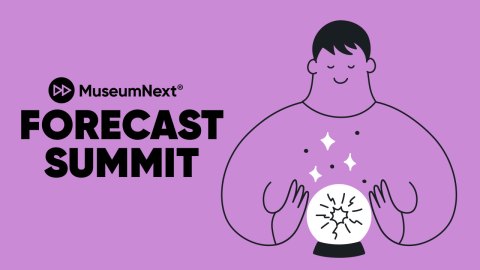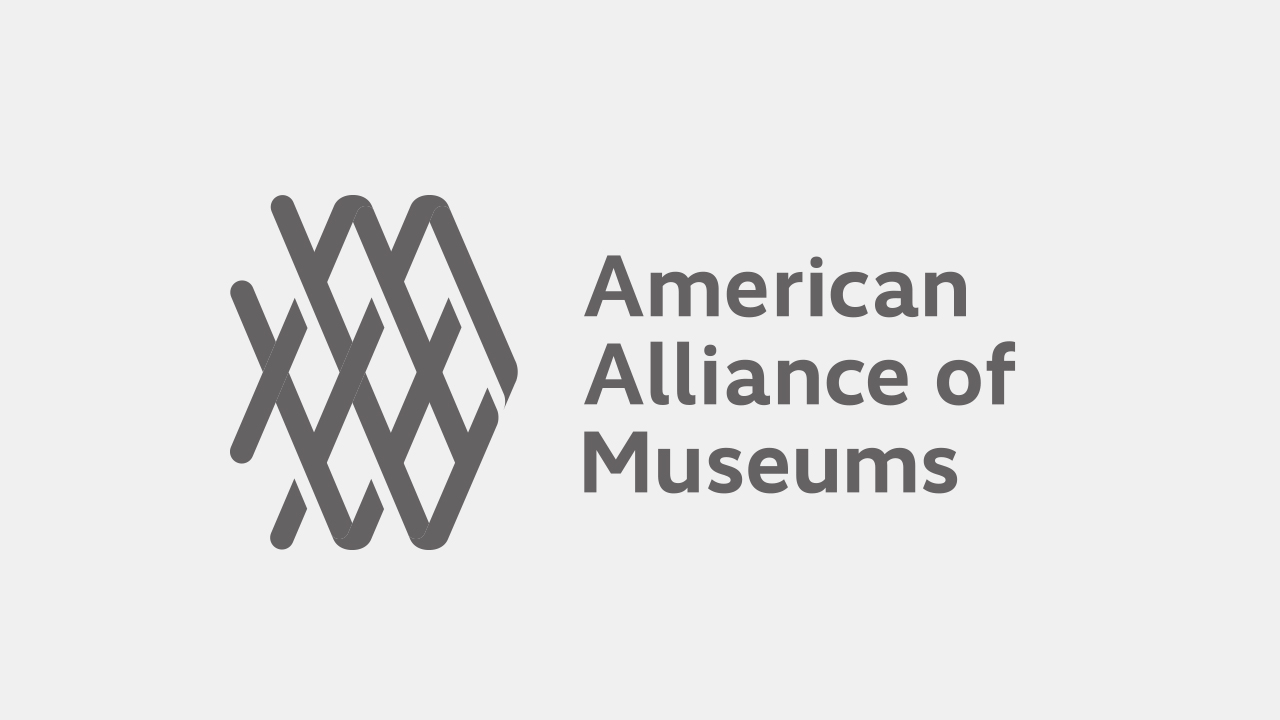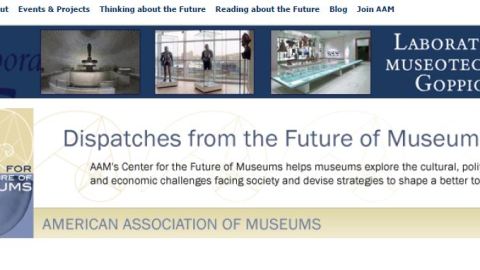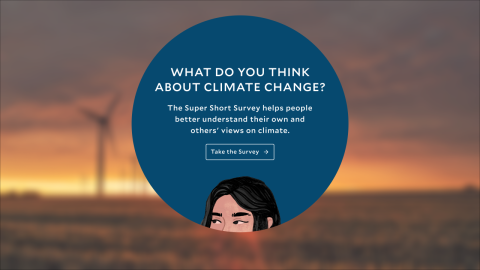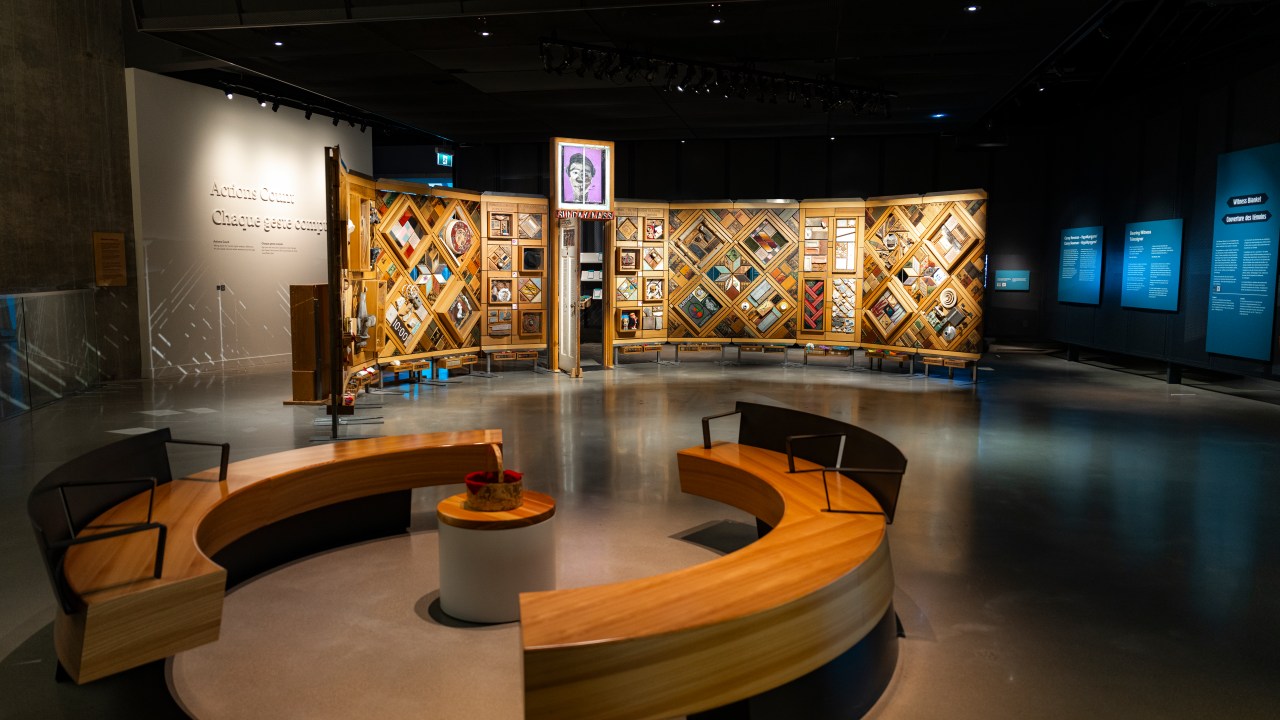
This article first appeared in the journal Exhibition (Spring 2025) Vol. 44 No. 1 and is reproduced with permission. If you don’t read the journal, become a member to receive your digital copy of the full upcoming issues or purchase the Spring 2025 issue.
Established in 2008 and opened in 2014, the Canadian Museum for Human Rights (CMHR; the Museum) is a relatively new institution. As the first Canadian national museum established outside Ottawa, the Museum’s purpose is “to explore the subject of human rights, with special but not exclusive reference to Canada, in order to enhance the public’s understanding of human rights, to promote respect for others and to encourage reflection and dialogue.”[1] Located in Winnipeg, Manitoba, the Museum’s presence and purpose are representative of the long and competing histories of its place: CMHR sits at the confluence of the Red and Assiniboine Rivers, a site of dialogue, celebration, and shared humanity from time immemorial—a meeting place of the Anishinaabeg, Ininew, Anisininew, and Dakota Oyate, and the birthplace and homeland of Red River Métis—while also standing “atop centuries of colonial invasion, settlement, and violent dispossession.”[2]
Although steadfast in its commitment to building the first museum in the world dedicated to the history and understanding of human rights, the Museum was guilty of undermining human rights values within the organization. In 2020, CMHR was forced to confront a crisis of ethics and identity: violations of the organization’s values and mandate, including self-censorship, anti-Black and anti-Indigenous racism, heterosexism and homophobia, and poor management of workplace human rights issues.[3]
Throughout this period of formation, confrontation, and ongoing transformation, the Museum’s relationship with the Witness Blanket has provided a guiding spirit and model within which we’re working to define and follow a new ethical practice.
The Witness Blanket
Inspired by Indigenous woven blankets, the Witness Blanket is a large-scale, participatory work of art created by multidisciplinary Indigenous artist, master carver, filmmaker, and author Carey Newman (Kwakwaka’wakw/Salish), whose traditional name is Hayalthkin’geme.[4] It bears witness to a terrible truth: During the 19th century, and as recently as 1997, more than 130 Indian residential schools operated across Canada (similarly, more than 500 Indian boarding schools operated across the United States). These schools were a deliberate attempt to destroy First Nations, Inuit, and Métis communities and ways of life, part of a broader process of colonization and genocide.
The Witness Blanket contains contributions donated by residential school survivors and their families, Indigenous communities, friendship centers, and governments. Other items featured in it were reclaimed from former residential school sites. Those responsible for the school system—churches and the Canadian federal government—donated pieces as a gesture toward reconciliation. In all, more than 800 items from 77 communities were gathered for this artwork. They include letters, photos, stories, books, clothing, art, and building fragments.
Every object donated to the Witness Blanket tells a story. One by one, they tell us about specific experiences in many times and places. Together, they tell us about the sweeping history of the residential schools that operated from coast to coast to coast for over a hundred years.[5]
The Witness Blanket is a monumental artwork, and it is so much more than that. Throughout its five-year national tour, the blanket was offered medicines and tokens that have been carefully tracked, mapped, and returned to their place in the exhibition at each subsequent location, becoming intrinsic parts of the Witness Blanket itself. Video footage from the creation of the Witness Blanket and its tour came together in an 85-minute documentary that is now exhibited with the blanket in our Actions Count Gallery.[6] Two true-to-scale replicas of the blanket were created to ensure it and the stories it carries could make their way to remote Indigenous communities and small towns where the demands of a large, complex, and fragile artwork could not be met. Two books, The Witness Blanket: Truth, Art and Reconciliation and Picking Up the Pieces: Residential School Memories and the Making of the Witness Blanket, both by Newman, bring these stories into the homes of visitors, while an online exhibition—WitnessBlanket.ca—offers an experience rich with oral histories, individual object stories, and curriculum-based teaching resources. In the coming year the Witness Blanket will come to life in both augmented reality and virtual reality, accompanied by soundscapes collected from across this land. In every iteration of the work—art, replica, book, video, soundscape, ceremony, web, and virtual reality—the stories and spirit are present, and we are invited to bear witness. This transmedia storytelling approach isn’t just about design. It is an ethical response to the power of the blanket’s stories and the need for them to be told and heard.
The relationship between Newman, the Museum, and the Witness Blanket is documented in a groundbreaking Stewardship Agreement that embeds rights and privileges in a cultural work through both Canadian and Indigenous law while resisting suggestions that the Witness Blanket is or was property to be transferred or owned. Text of the agreement can be found on WitnessBlanket.ca; however, the document does not represent the entire agreement. In 2019, Newman and representatives of the Museum gathered in the Big House in K’ómoks (Comox, Vancouver Island) and, through ceremony, committed to their roles as story keepers. In September 2024, the story keepers gathered again to feast the agreement, in a form of governance that has existed from time immemorial: a shared meal. Community members were called to witness both ceremonies, retaining and caring for the memory of what was and wasn’t seen, said, felt, and communicated, becoming responsible for sharing that knowledge with others; many witnesses from the first ceremony in 2019 attended the feast in 2024. Making the agreement in accordance with both Western and Indigenous law means that the words written in the document must be understood alongside the spirit and experiences of the ceremonies that shape it.[7]
And, while sector-wide debates surrounding museum ethics and repatriation of cultural artifacts continue, the Witness Blanket’s future has already been made clear: the Stewardship Agreement binds Newman and the Museum to consider the next seven generations in our work together while acknowledging that nothing lives forever. A time will come when the Witness Blanket will be laid to rest. While this may challenge the orthodoxy of museum collecting and preservation “in perpetuity,” it has also offered nuance to ethical decisions around the Witness Blanket and its conservation.[8] For example, we do not display the blanket’s face in direct sunlight, but nor do we fully isolate it from the outside world. Visitors are able—although not actively invited—to touch the surface of the blanket if they are called to do so, while fragile objects on it are protected by glass-fronted shadowboxes. In part, the finite existence referenced in the Stewardship Agreement is directly connected to the purpose and work of the Witness Blanket: there are stories that must be told here and now, and there is an urgency to the work the blanket was created to do.
Our Emerging Ethics Practice
In reflecting on the ways we approach the ethics of the blanket, we find some clarity in the work of psychologist and ethicist Carol Gilligan, who uses the analogy of ambiguous figure perception—the phenomenon wherein a single drawing can be perceived by different people as one of two very different images—to illustrate how two moral perspectives can be at play in organizations simultaneously: ethics that focus on justice, and those that center on care (fig. 1). Gilligan notes that our perception of an ethical dilemma, like the classic profile/vase or rabbit/duck images, relies not only on the features of the image presented, but also on our individual experiences or expectations. Like the dual images, both ethical perspectives exist, but we may not see the ambiguity unless someone explicitly states that an object, situation, or event can be seen another way. Even when people are aware of both perspectives, they tend to embrace one or the other in the face of moral conflict.[9]

Although Canadian law does not offer a direct equivalent to America’s Native American Graves Protection and Repatriation Act (NAGPRA), Canadian museums are similarly bound by legal obligations toward sovereign Indigenous nations. Additionally, as a member of the International Council of Museums, the American Alliance of Museums, and the Canadian Museums Association, CMHR is bound by the codes of ethics of each of these associations, as well as by the professional codes that govern the career practice of the public servants, collections specialists, registrars, conservators, accountants, engineers, and others who work within our walls. Much of the content of these statements leans heavily on the justice-centered ethical frame and obligates museums to act according to law. And yet, CMHR’s galleries are a testament to countless situations where ethical violations occurred with full compliance with the law. Applied as a singular perspective on ethics, codes that focus only on legal requirements create a risk that we see only one part of the picture. While critical, acting lawfully is often insufficient.
In contrast to the rules-based justice perspective, ethics of care are those where the interdependence of people is understood, where others affected by our ethical choices are given consideration in proportion to their vulnerability, and where ethical choices are shaped by situational details that inform how best to safeguard and promote the interests of the individuals involved.
In 2024, the Museum adopted “Our Path Forward,” an articulation of how we work and what we do in this place. Grounded in a theory of change and shaped by the experiences of the first 10 years of the Museum’s existence, Our Path Forward focuses CMHR’s work on hosting transformative experiences, sharing stories that inspire action, and modeling human rights practices—and it places relationships at the center of it all. By centering relationships and embracing Indigenous ways of knowing, being, and doing, the Museum’s ethical practice is being shaped into one that sees both parts of the ethical picture—justice and care—at once.
Doing Work That Is Care-Full
Our team aims to practice curation grounded in the Latinate origins of the word: cura, to care. This care-full approach extends beyond preservation of materials and has been shaped by our experience with the Witness Blanket to incorporate emotional, cultural, and spiritual care—inviting reflection, understanding, and a sense of shared responsibilities for the stories being told (fig. 2).
Through our relationship with the Witness Blanket, we’re working to apply this care to all our relations, and all the stories we tell:

Expanding Access Through Multimodal Storytelling
We are often called upon to tell stories of great significance. Unfortunately, the public’s relationship to museums and to Canada’s vast geography can easily conspire to limit access to exhibitions for certain audiences. Our experience with the Witness Blanket has shaped our approach to exhibition practice, inspiring a comprehensive exhibition model that not only encourages the creation of transmedia storyworlds but also connects with a diverse range of visitors through multiple elements and approaches—not for effectiveness alone, but out of an ethical drive to honor the stories entrusted to our care in the broadest ways possible.
Honoring Relationships
The objects and histories that are most valuable to our exhibition practice and collections mandate are those that represent lived stories of human rights. Those lives are embodied in relationships, and through our work with the Witness Blanket we are learning that relationships require ongoing reciprocity, responsibility, and respect.
Maintaining Ties Between Donors and Their Histories
In reviewing our Collections and Stewardship Policy, we are working to develop systems that support our ability to maintain connections with the individuals connected to an object; for example, notifying families when their belongings are on display, offering donors lifetime memberships, or considering when it might be appropriate to support a donor’s travel to CMHR—either to carry their belongings or to meet their artifacts at the Museum—so that they can maintain a long-term physical connection to the place where their families’ stories will rest. Our Collections and Stewardship Policy also includes a deaccessioning provision allowing any donor of an artifact or contributor of an oral history to withdraw their contribution or consent, and to the fullest extent possible, their belongings or histories will be returned.
Supporting Visitors on Their Journeys
Caring for stories also means caring for everyone who has a relationship to those stories, and for everyone who may be building a relationship to those stories for the first time. Gallery hosts—paid museum staff present in our galleries—are trained to facilitate learning and to support every visitor in their emotional responses to content. Visitor care plans for exhibitions include identifying spaces for rest or reflection and preparing our team with connections to psychosocial supports. Our spatial design practices offer visitors clear introductions to gallery content upon arrival, consider routes of travel that allow visitors to bypass especially difficult content, and consider where hosts might be best positioned to support visitors. Practices are in place to monitor participatory exhibits and to identify when a visitor has expressed distressing emotions that might indicate a risk of self-harm, and team members communicate from gallery to gallery when they have met a visitor whom they think might benefit from added care or connection as they move through the Museum.
Caring for Staff
Doing this work in a care-full way also has a unique impact on our team. Telling the stories of the Indian Residential School System can sometimes invite hard conversations with genocide deniers, just as telling stories of the Holocaust sometimes does. Gallery staff are trained to navigate microaggressions from visitors, while holding space for the learning that can come from those difficult interactions. Gallery staff are not expected to remain in a single gallery for more than an hour, and time off the gallery floor for reflection, rest, and peer support is incorporated into the daily schedule. With the support of a psychologist who specializes in trauma, our curators, exhibition designers, researchers, and collections and stewardship staff are developing peer-support approaches to prevent, recognize, and respond to trauma in our relationships and work. We are rethinking our practices relating to object research, loan agreements, and collections management to ensure all our interactions are trauma-aware, and we are working to prevent trauma activation while also developing the skills to manage trauma when it is, inevitably, activated.
Museum workers have always been trained to care for objects: to ensure food stays out of galleries, to know when it’s important to wear gloves to handle artifacts and why those gloves come off for works on paper. Over the course of 10 years of telling difficult human rights stories and through our relationship with the Witness Blanket, we’re now developing our skills in handling our visitors, communities, and colleagues with the same care.
Looking Back to Look Forward
On September 20, 2024, when CMHR board trustees, educators, curators, collections stewards, Elders, executives, administrators, volunteers, and visitors gathered alongside Newman, Chief Wedlidi Speck,[10] witnesses, story keepers, and the Witness Blanket itself, they once again feasted together, as they had in 2019, at the beginning of the blanket’s journey (fig. 3).
Gathering to feast and to take care of our relationships was not only an obligation set upon the Museum and Newman in the 2019 Stewardship Agreement, it was also a reunion, an opportunity for honest reflection, and a cultural celebration that marked both five years of shared stewardship, and 10 years of this remarkable project.

Relationships are at the center of Indigenous ways of being, knowing, and doing—relationships do not merely shape reality, they are reality, and the shared aspect of an Indigenous methodology is accountability to relationships.[11] Understood through this paradigm, the Stewardship Agreement invited CMHR into a new model that was unorthodox in the tradition of Crown museums. By accepting the invitation to steward the Witness Blanket, the Museum accepted a new accountability that would, inevitably, incorporate an ethics of care into its museological practice.
The feast represented significant growth and change in the Museum. “We held a council to speak about the changing needs of the blanket, five years into our agreement, and begin the process of looking forward at our shared responsibilities across the years ahead,” Newman reflected. “It was wonderful to hear from [former Museum staff] who despite having moved on from their time at the CMHR, remain connected to the work we began together.”[12]
During that feast, however, witnesses and story keepers also reminded us that just 10 years ago, when the Museum was preparing for its opening day, the story looked very different: Elders and Indigenous leaders were gathered outside in protest of the Museum. The Museum was placed on this land without consent, failed to recognize the harms in which it was complicit, was unable to acknowledge the genocide against Indigenous people that is now broadly accepted in Canada, and, in our effort to tell diverse human rights stories, had failed in our commitments to many communities. On this day 10 years later, many of those who protested outside in 2014 were now inside, sitting in circle with us as we feasted the blanket and the agreement.
Over the course of 10 years, we have been called to bear witness to the competing truths of this Museum: it represents a history of storytelling, dialogue, and sharing that has existed in this place since time immemorial, and it represents colonial violence and the imposition of the Canadian state on this land and its people.
In response, we are asking ourselves questions that every museum and museum worker might contemplate:
- If relationships are reality and instill accountability, what relationships are we caring for in our work each day?
- What accountabilities—to individuals, to communities, and to protocols and practices—are inherent in the belongings we care for and the stories we hold?
- Do our policies and processes support these accountabilities or frustrate them?
- Are we doing enough to honor and share the stories that are gathered in our exhibitions?
- Are we supporting our teams, our visitors, and ourselves as we grow in our relationships with our work, with one another, and with our pasts?
- Are we going beyond what must be done to consider what should be done, by considering not only what is just but also what is care-full?
In the same way that one’s eye can be trained to see both the rabbit and the duck in an ambiguous figure, we have learned (and continue to learn) to see the competing truths of this place.
In the same way that one’s eye can be trained to see both the profile and the vase, our ethics practices as museum professionals can be trained to focus not just on an ethics of justice and codes, but also on an ethics of care.
The Witness Blanket has taught us this and so much more; and still, we have so much more yet to learn.
Felix Berry is Curator at the Canadian Museum for Human Rights (CMHR) in Winnipeg, Manitoba.
Matthew Cutler is Vice-President, Exhibitions, and Head of Curation at CMHR.
Lisa Quirion is Manager, Collections and Stewardship, at CMHR.
[1] “Museums Act,” Consolidated Acts (S.C. 1990, c.3).
[2] Mandi Gray and Karl Gardner, “(In) Visible Histories: Colonialism, Space and the Canadian Museum for Human Rights,” Annual Review of Interdisciplinary Justice Research 5(Winter 2016): https://www.cijs.ca/volume-5.
[3] Harris Law Solutions, “Rebuilding the Foundation: External review into systemic racism and oppression at the Canadian Museum for Human Rights, August 2020, https://humanrights.ca/sites/prod/files/2020-08/A-FullReport_EN.pdf.
[4] Through his father, Newman is Kwakwak’awakw from the Kukwekum, Giiksam, and WaWalaby’ie clans of Northern Vancouver Island, and Coast Salish from Cheam of the Sto:lo Nation along the upper Fraser Valley. Through his mother, his ancestors are Settlers of English, Irish, and Scottish heritage.
[5] “Discover the Witness Blanket,” accessed March 12, 2025, witnessblanket.ca. This website was co-created with Carey Newman, an Elders circle supported by the National Centre for Truth and Reconcilation, and Animikii, an Indigenous technology firm.
[6] See, Picking Up the Pieces: The Making of the Witness Blanket, Canadian Museum for Human Rights, March 20,2020, updated September 18, 2024, vimeo, 1:26:48, https://humanrights.ca/story/picking-pieces-making-witness-blanket.
[7] For more detail, see “Decolonizing Contracts – Carey Newman,” Weweni Indigenous Scholars Speakers Series, University of Winnipeg, February 7, 2022, YouTube, 56:27, https://www.youtube.com/watch?v=e8Ub3865Tb4
[8] From 2019 to 2022, the Museum undertook an extensive preservation and conservation project alongside staff from the Canadian Conservation Institute and the Manitoba Museum to lead this project. For more details see, Skylar Wall, Cindy Colford, Carolyn Sirett, Stephanie Chipilski, and Carey Newman, “Caring for the Witness Blanket: A decolonizing approach to conserving Indigenous artwork,” Canadian Museum for Human Rights, May 15, 2023, https://humanrights.ca/story/caring-witness-blanket.
[9] Carol Gilligan, “Moral Orientation and Moral Development,” in Women and Moral Theory, ed. Eva Feder Kittay and Diana T. Meyers (Rowman & Littlefield: 1987), 19–33.
[10] Chief Speck is E’ikʷsən Hereditary Chief with cultural connections to the Kwakwaka’wakw, Nuu-chah-nulth, and Northern Vancouver Island Coast Salish tribes located on the Pacific Northwest Coast.
[11] Shawn Wilson, Research Is Ceremony: Indigenous Research Methods (Nova Scotia: Fernwood Publishing, 2008).
[12] Carey Newman, “Reflections on the Feast of the Stewardship Agreement,” Facebook, September 24, 2024, video, 13:52, accessed March 16, 2025, https://www.facebook.com/carey.newman.7/posts/.
